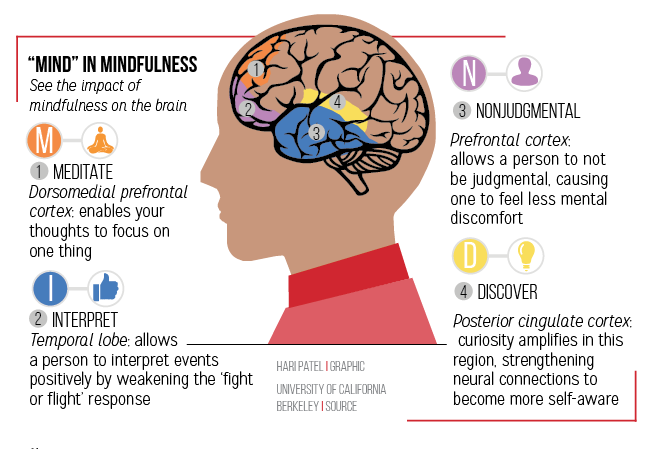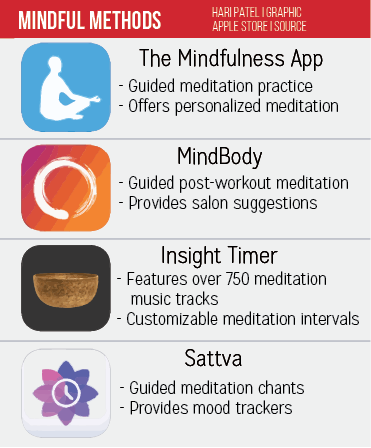Every Gold Day, junior Aubrie Bradbury comfortably sits crossed-legged and leans against large bean bags for back support during meditation exercises, directed over the speakers. She follows its directions, inhaling and exhaling when told, sometimes smiling when something unexpected interrupts the flow. She folds her hands in a prayer before brightly opening her eyes again, revitalized and ready to tackle the class.
Competing in the demanding environment that is CHS, Bradbury centers herself with a skill not many have heard of: mindfulness, which, according to Bradbury, keeps her grounded while managing all of the work she has to do in the little time she has.
She said, “When I think of mindfulness, I think it’s being conscious of the present, being physically and emotionally present in whatever situation is going on around you, being aware of not only the situation, but the people, and taking everything into consideration when it comes to addressing certain things.”

Junior Aubrie Bradbury practices mindfulness through meditation at the beginning of Theory of Knowledge (TOK) class. Although breathing meditation is the most common way to practice mindfulness, there are other ways to
practice it.
Mindfulness is a term most familiar to International Baccalaureate (IB) students who take Theory of Knowledge (TOK) in which students learn how to practice it every class.
TOK teacher Allyson Wells-Podell said, “The biggest reason I was motivated to incorporate mindfulness into TOK is because the IB encourages a balanced student and a reflective student, and I think that mindfulness plays a big role in both of those.”
However, Bradley Sever, Assistant Principal and IB director, said, mindfulness is an ambiguous term, and in order for it to be effective, the first step is to define it.
According to the Greater Good Science Center at University of California Berkeley, mindfulness is awareness with oneself and the environment. Jon Kabat-Zinn pioneered and documented studies of its health benefits through the Mindfulness-Based Stress Reduction Program (MBSR) in public centers.

Bradbury said the style of MBSR fits well with her, and after experimenting with meditation as a freshman, she said she revitalized her thinking this year.
“I lost track of (it),” Bradbury said. “But, this year in classes like TOK, even in some of my other IB classes, my teachers encourage setting aside time to just sit and be present, let go of all of our (responsibilities). That really does play into mindfulness and as far as a mental health standpoint, I think without it, my psyche would just suffer a lot.”
Wells-Podell said this was another reason why she implemented mindfulness in TOK.
“I think a lot of classes can create some unbalance, and our students can feel stressed out and overwhelmed by their school workload and all the extracurriculars that they’re doing. But to practice mindfulness can help us stay balanced and help us feel more balanced everyday,” she said.
Furthermore, according to Frank Diaz, professor and co-director of the Mind and Music Lab at Indiana University, mindfulness has elevated the genuine reception of teaching.
Diaz said via email, “To me, teaching becomes mindful when it is imbued with practices that help us refine and stabilize our attention, along with developing a non-judgmental attitude to what arises in our experience. There are numerous ways one can incorporate mindfulness into almost any learning task, but I believe it is important that teachers practice it themselves so that their applications are genuine, ethical and informed.”
This can be a target for teaching in CHS as students can improve their learning experience with sustained attention. Sever said he believes everyone can benefit from mindfulness especially as students can see the immediate value in their education.
“I think there’s two ways people can have an authentic experience,” Sever said. “One, it’s authentic to them. Two, if you can see how the content you are learning is applied to the world. When people see the connection and the application, they see the value.”

However, active mindfulness exercises in the classroom may not be for everyone.
Diaz said, “Since mindfulness is about learning to be fully aware and present for anything that arises in your body, mind and emotions, individuals with trauma, severe anxiety and clinical depression may experience negative effects from mindfulness if they are not working with a mental health professional. Although this is rare, it is something to consider when teaching mindfulness to others.”
Even so, Bradbury said she experiences the advantages mindfulness has for learning.
Bradbury said, “I feel like if I’m not giving 100 percent or if I’m constantly working on things one right after the other, I’m not taking the time to refresh my brain to switch from science to an art, to switch project to project; by having that brief moment of mindfulness of being aware of the present and being mentally ready to take on the next task. It dramatically increases my academic scores.”































![What happened to theater etiquette? [opinion]](https://hilite.org/wp-content/uploads/2025/04/Entertainment-Perspective-Cover-1200x471.jpg)













































![Review: “The Immortal Soul Salvage Yard:” A criminally underrated poetry collection [MUSE]](https://hilite.org/wp-content/uploads/2025/03/71cju6TvqmL._AC_UF10001000_QL80_.jpg)
![Review: "Dog Man" is Unapologetically Chaotic [MUSE]](https://hilite.org/wp-content/uploads/2025/03/dogman-1200x700.jpg)
![Review: "Ne Zha 2": The WeChat family reunion I didn’t know I needed [MUSE]](https://hilite.org/wp-content/uploads/2025/03/unnamed-4.png)
![Review in Print: Maripaz Villar brings a delightfully unique style to the world of WEBTOON [MUSE]](https://hilite.org/wp-content/uploads/2023/12/maripazcover-1200x960.jpg)
![Review: “The Sword of Kaigen” is a masterpiece [MUSE]](https://hilite.org/wp-content/uploads/2023/11/Screenshot-2023-11-26-201051.png)
![Review: Gateron Oil Kings, great linear switches, okay price [MUSE]](https://hilite.org/wp-content/uploads/2023/11/Screenshot-2023-11-26-200553.png)
![Review: “A Haunting in Venice” is a significant improvement from other Agatha Christie adaptations [MUSE]](https://hilite.org/wp-content/uploads/2023/11/e7ee2938a6d422669771bce6d8088521.jpg)
![Review: A Thanksgiving story from elementary school, still just as interesting [MUSE]](https://hilite.org/wp-content/uploads/2023/11/Screenshot-2023-11-26-195514-987x1200.png)
![Review: "When I Fly Towards You", cute, uplifting youth drama [MUSE]](https://hilite.org/wp-content/uploads/2023/09/When-I-Fly-Towards-You-Chinese-drama.png)
![Postcards from Muse: Hawaii Travel Diary [MUSE]](https://hilite.org/wp-content/uploads/2023/09/My-project-1-1200x1200.jpg)
![Review: "Ladybug & Cat Noir: The Movie," departure from original show [MUSE]](https://hilite.org/wp-content/uploads/2023/09/Ladybug__Cat_Noir_-_The_Movie_poster.jpg)
![Review in Print: "Hidden Love" is the cute, uplifting drama everyone needs [MUSE]](https://hilite.org/wp-content/uploads/2023/09/hiddenlovecover-e1693597208225-1030x1200.png)
![Review in Print: "Heartstopper" is the heartwarming queer romance we all need [MUSE]](https://hilite.org/wp-content/uploads/2023/08/museheartstoppercover-1200x654.png)



